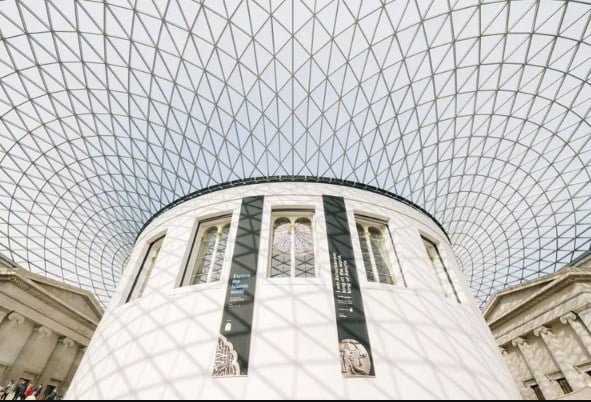The national museum, which is free for visitors in its permanent collection, has an expansive range of cool stuff, including Egyptian mummies, the Rosetta Stone and the Sutton Hoo ship burial. It welcomes travelers of all ages and its experience can be tailored to any attention span or interest. Be sure to include the museum in your London itinerary, even if it’s just to come in to see the impressive Great Court or to catch a glimpse of some historic samurai armor.
Museum History
Founded in 1753, the British Museum first opened its doors to the public in 1759 as the first national museum to cover all fields of human knowledge. The museum was created by an act of Parliament and was intended to invite in “all studious and curious persons,” meaning that the initial visitors needed to apply for tickets. In the 1830s, the museum began to welcome in more and more visitors, and today more than six million people explore the British Museum each year. Its collection now includes around eight million objects, which cover two million years of human history, and the Reading Room, completed in 1857, has become a popular place to seek out knowledge.

The museum’s much-photographed Great Court, which is known in full as Queen Elizabeth II Great Court, is the largest covered public square in Europe. The two-acre room, designed by Foster and Partners, was redesigned reopened in 2000 (when it was opened by the Queen herself). Inside, visitors can find the Lion of Knidos, among other famed antiquities.
What to See and Do
The British Museum can be overwhelming as there’s a lot to see in the museum’s permanent collection. Some of the highlights include the Egyptian sculpture gallery, where you’ll find the Rosetta Stone and the Statue of Ramesses II, and the Africa Galleries, which include both antiquities and contemporary pieces. The entire world is represented throughout the galleries, from Oceania to Japan to Britain itself, so it’s best to plan a route that suits your interests. The British Museum’s museum map offers several possible trails to follow through the rooms, including one suited to kids and another that looks specifically at LGBTQIA+ history.
The museum typically hosts one or two special exhibitions alongside their collection at any given time, which you can check out in advance on their website. The special exhibitions are usually hosted for several months and most require a purchased tickets to enter. The institution’s calendar also includes regular lectures, talks and special events, some of which are free to visitors.
Once you’ve fully explored the galleries and exhibitions, head to one of the museum’s eateries. These include the Court Café, a casual spot inside the Great Court serving sandwiches, snacks and drinks, and the Great Court Restaurant, which serves morning tea and coffee, lunch and afternoon tea, as well as dinner on Fridays when the museum is open late. There is also the Pizzeria, Montague Café and the Coffee Lounge, and food trucks can frequently be found in the outdoor area of the museum along with tables.
How to Visit
The British Museum is an extremely popular attraction for visitors to London and it’s easily accessible in the central part of the city. Because the museum is convenient to other attractions, including the West End and Trafalgar Square, and because the permanent collection is free, a visit to the British Museum can be as long or short as you want. Whether you prefer to stop by to see the Rosetta Stone…
Visitors are required to purchase tickets for any special exhibitions (which can be done in advance online or at the ticket office), but entry to the regular collection is free and doesn’t require a ticket. The museum is open Monday through Sunday, closing during the year only from December 24-26, and last entry is at 3:30 p.m. daily. The museum also hosts late hours on Fridays, with the galleries open until 8:30 p.m. alongside events and talks.
Getting There
The British Museum is located on Great Russell Street near Russell Square and can be accessed easily from several London Underground stations. The museum is equidistant from the Russell Square, Tottenham Court Road, Goodge Street and Holborn Tube stations, which serve numerous London Underground lines. There is also a variety of London bus lines that stop close to the museum, including the 14, 168, 176, 19, 24, 38, 68, 8 and 98. Use the Transport for London Trip Planner tool to find your best route to the museum.
For those who prefer not to take public transportation , look for London’s black cabs or use the Uber app to hail a ride share car. When leaving, head to the taxi rank on Great Russell Street at the museum’s main gates. There is no parking at the museum so it’s best to avoid driving your own car into Central London when visiting. Bicycle racks are also available inside the gates of the Main Entrance on Great Russell Street.

Tips For Visiting
All visitors are required to pass through a security check, which includes a bag search, at the entrance to the British Museum. Be sure to be prepared and avoid bringing in large luggage. Wheeled suitcases and sports equipment are not allowed inside the museum. Luggage storage can be found at nearby train stations, including Euston, King’s Cross and Charing Cross.
The British Museum has an easy access route for those with accessibility issues. The route is available for disabled visitors and visitors with strollers and/or children under five, as well as museum members. Strollers are allowed, but must be kept with you during your visit. Wheelchairs can be reserved in advance for those who need them.
Free Wi-Fi is available to all visitors. Look for the “British Museum WiFi” network on your device and enter your name and email address to access.
Most galleries allow hand-held flash photography and video recording as long as it’s for private purposes, although tripods, monopods and selfie sticks are not allowed. Watch for signs indicating when photography is prohibited
Don’t miss the British Museum Shop, which sells a huge array of souvenirs and gifts, from books to jewelry to small replicas of some of the museum’s memorable works.
If you plan to make several visits to the British Museum or simply want to support the institution, consider purchasing a museum membership. There are several levels of membership and all include unlimited free access to the special exhibitions and access to the Members’ Room.

